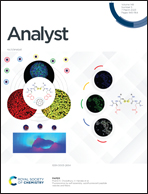Visualized RNA detection of SARS-CoV-2 in a closed tube by coupling RT-PCR with nested invasive reaction†
Abstract
A simple, cost-effective and reliable diagnosis of pathogen nucleic acids assay is much required for controlling a pandemic of a virus disease, such as COVID-19. Our previously developed visualized detection of pathogen DNA in a single closed tube is very suitable for POCT. However, virus RNA could not be detected directly and should be reverse-transcribed into cDNA in advance. To enable this visualized assay to detect virus RNA directly, various types of reverse transcriptase were investigated, and finally we found that HiScript II reverse transcriptase could keep active and be well adapted to the one-pot visualized assay in optimized conditions. Reverse transcription, template amplification and amplicon identification by PCR coupled with invasive reaction, as well as visualization by self-assembling of AuNP probes could be automatically and sequentially performed in a closed tube under different temperature conditions, achieving “sample (RNA)-in-result (red color)-out” only by a simple PCR engine plus the naked eye. The visualized RT-PCR is sensitive to unambiguous detection of 5 copies of the N and ORFlab genes of SARS-CoV-2 RNA comparing favourably with qPCR methods (commercialized kit), is specific to genotype 3 variants (Alpha, Beta and Omicron) of SARS-CoV-2, and is very accurate for picking up 0.01% Omicron variant from a large amount of sequence-similar backgrounds. The method is employed in detecting 50 clinical samples, and 10 of them were detected as SARS-CoV-2 positive samples, identical to those by conventional RT-PCR, indicating that the method is cost-effective and labor-saving for pathogen RNA screening in resource-limited regions.

- This article is part of the themed collection: Analyst HOT Articles 2023


 Please wait while we load your content...
Please wait while we load your content...